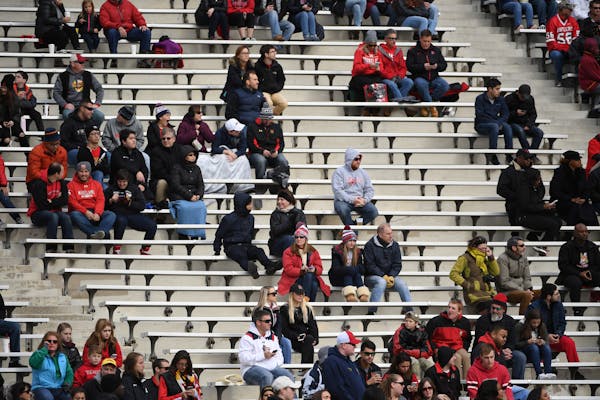By many standards, University of California, Berkeley, has an incredible sports program. Its 30 sports are second only to Stanford in the Pac-12 Conference, and the school has won 22 national titles in the past decade. At the Rio Olympics, current or former Cal athletes collected 21 medals, including eight golds.
By another measure, Cal sports are in big trouble. After completing the most expensive college football stadium overhaul ever, the Golden Bears now owe more money than any other college sports program. Hobbled by debt service payments, the athletic department ran a $22 million deficit last year and expects to end this fiscal year deep in the red.
A university task force is looking for possible solutions, including reducing the total number of Cal's sports programs. Any cuts could endanger some of the school's most successful teams, which cost a lot more than they bring in, and Chancellor Nicholas Dirks recently gave the group more time. "Everything is on the table," said Robert O'Donnell, a lecturer at Berkeley's Haas School of Business who co-chairs the task force.
Football critics nationwide often point to multimillion-dollar coaches as emblems of excess. They should be more worried about debt, which costs more and lasts longer. A high-priced coach might earn $4 million to $5 million a year. Meanwhile, according to public records, athletic departments at least 13 schools in the country have long-term debt obligations of more than $150 million as of 2014 — money usually borrowed to build ever-nicer facilities for the football team.
For some schools, millions in TV money can support a high level of debt service. That includes the University of Alabama, which plays Clemson for the national championship on Monday. The Crimson Tide owes $225 million over the next 28 years. In the Big Ten, also flush from a rich media deal, the University of Illinois owes more than $260 million. If that revenue stream fails to grow or starts to drop, as it already has for some programs in the top tier of college football, the results could be crippling.
"Leaders need to be very careful that long-term expenses and commitments cannot, and should not, be balanced on the assumption that these traditional media rights deals will hold up," said Karen Weaver, a sports-management professor at Drexel University and specialist in college media rights.
Many in college sports are more optimistic. Pac-12 Commissioner Larry Scott, for example, has said he expects that his schools will make more money from media as rights get carved up among traditional broadcasters and digital streaming platforms. All of the biggest conferences signed rich, multiyear television contracts recently, and most athletic directors believe the money will continue to flow into the next round of negotiations as well.
At Kansas State, athletic director John Curry said he won't borrow for anything but football and basketball, the two sports that make money. The Wildcats, who compete in the Big 12 Conference, have built $210 million in new facilities under Curry while accruing modest annual debt service of about $6 million. "We've looked very seriously at the fact that our debt service needs to remain as close to that number as it can as the landscape continues to evolve," Curry said.
Cal's debt service last year cost nearly three times as much, the main reason why a department that generally balances its budget had such a massive deficit. Annual payments will be $18 million until 2032, when they jump to $26 million. They'll peak at $37 million a year in 2039. The school plans to pay off the full sum by 2053, though the loan extends to 2112.
The renovation at Berkeley was always going to be expensive-California Memorial Stadium sits directly on Hayward Fault and needed specific earthquake-related upgrades-but the athletic department planned to pay for it through an "Endowment Seating Program," decades-long season ticket packages for up to $225,000 each. Sales fell short of expectations; a year after the $474 million renovation finished, the athletic department revised its plans.
At about the same time, the university brought in a new athletic director, Mike Williams, a onetime Cal wrestler who went on to work in corporate finance. In his search for new ways to make money, Williams has negotiated an apparel contract with Under Armour and a media-rights deal that together will increase revenue by $7 million annually for the next decade. Still, Williams said, "We need to do more."
Enter the Chancellor's Task Force on Intercollegiate Athletics, charged with reviewing the department's finances and making recommendations. O'Donnell said the group is still in "input gathering mode." The Mercury News reported that more than one-third of Cal's sports could be on the chopping block. An administrative overhaul to lower expenses is also possible, or the broader university could increase the money it devotes to athletics, currently around $5 million.
There may be limits to how much help can come from central campus. Overall, Cal had a $150 million deficit last year and is up against its borrowing limit. "Not only does athletics have a problem on account of the debt service, but it's also taking up a huge chunk of our available borrowing," said physics professor Bob Jacobsen, a faculty representative for athletics. Meanwhile, he added, professors are losing research opportunities due to funding concerns.
Debt can be a tool to grow-especially when interest rates are low-but only if it's used properly, according to the Georgia Tech athletic director Todd Stansbury. In September, he inherited a department with $226 million of debt. Most of the $13 million annual debt service, however, is linked to pledged donor contributions. "When it's done that way, it's both healthy and sustainable," Stansbury said. "When it starts to eat into your operations budget, then it becomes highly problematic."

After Wild miss playoffs, who will stay and who will go?

